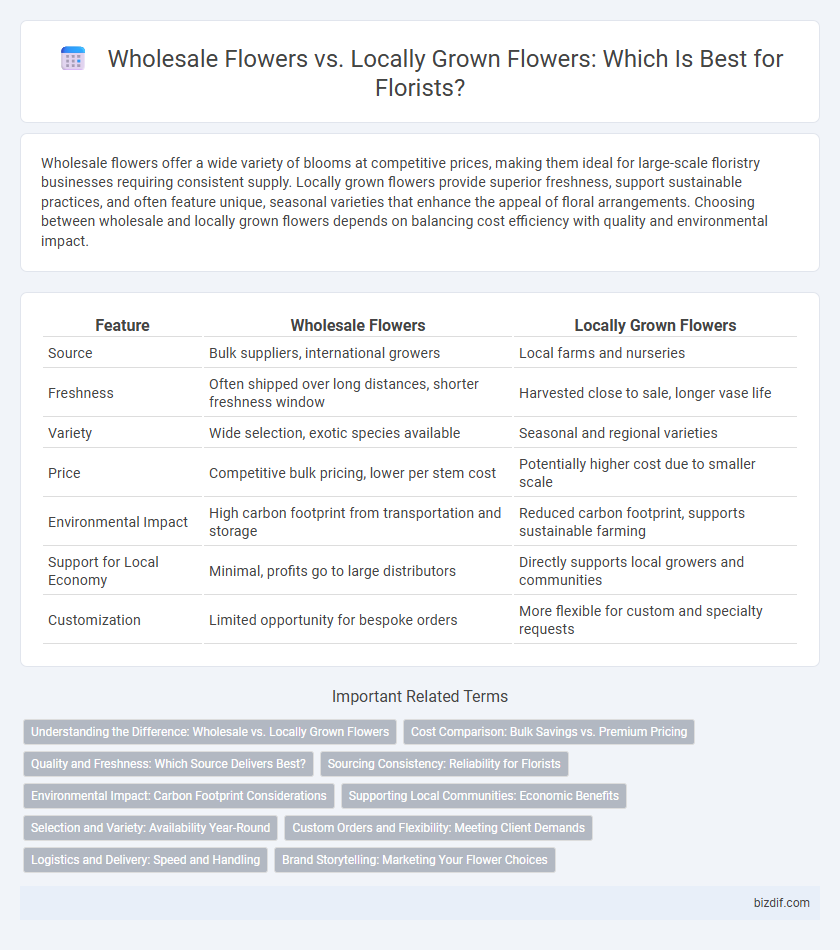Wholesale flowers offer a wide variety of blooms at competitive prices, making them ideal for large-scale floristry businesses requiring consistent supply. Locally grown flowers provide superior freshness, support sustainable practices, and often feature unique, seasonal varieties that enhance the appeal of floral arrangements. Choosing between wholesale and locally grown flowers depends on balancing cost efficiency with quality and environmental impact.
Table of Comparison
| Feature | Wholesale Flowers | Locally Grown Flowers |
|---|---|---|
| Source | Bulk suppliers, international growers | Local farms and nurseries |
| Freshness | Often shipped over long distances, shorter freshness window | Harvested close to sale, longer vase life |
| Variety | Wide selection, exotic species available | Seasonal and regional varieties |
| Price | Competitive bulk pricing, lower per stem cost | Potentially higher cost due to smaller scale |
| Environmental Impact | High carbon footprint from transportation and storage | Reduced carbon footprint, supports sustainable farming |
| Support for Local Economy | Minimal, profits go to large distributors | Directly supports local growers and communities |
| Customization | Limited opportunity for bespoke orders | More flexible for custom and specialty requests |
Understanding the Difference: Wholesale vs. Locally Grown Flowers
Wholesale flowers typically offer a broader variety and larger quantities at competitive prices, making them ideal for large-scale florists and event planners. Locally grown flowers provide fresher, seasonal blooms with a smaller carbon footprint, supporting regional growers and ensuring peak quality and fragrance. Understanding these differences helps buyers balance cost, freshness, and sustainability preferences in floristry.
Cost Comparison: Bulk Savings vs. Premium Pricing
Wholesale flowers offer significant cost savings due to bulk purchasing and centralized distribution, often resulting in lower per-stem prices compared to locally grown flowers. Locally grown flowers typically command premium pricing driven by higher production costs, smaller-scale operations, and the emphasis on freshness and sustainability. Choosing between the two depends on budget priorities and the value placed on supporting local growers versus maximizing volume savings.
Quality and Freshness: Which Source Delivers Best?
Wholesale flowers often offer a broad variety at competitive prices but may sacrifice freshness due to longer transportation times and storage. Locally grown flowers typically ensure superior quality and vibrant freshness, as they are harvested closer to the point of sale and reach consumers faster. Prioritizing local sourcing supports seasonal blooms that maintain optimal appearance and fragrance, enhancing overall floral arrangement quality.
Sourcing Consistency: Reliability for Florists
Wholesale flowers offer florists a reliable and consistent supply due to high-volume production and streamlined distribution networks, ensuring availability regardless of seasonal fluctuations. Locally grown flowers provide fresher blooms with unique regional varieties but may face limitations in availability and seasonal consistency. Florists prioritize sourcing consistency to maintain inventory levels and meet client demands, often balancing wholesale reliability with the freshness of local options.
Environmental Impact: Carbon Footprint Considerations
Wholesale flowers often travel long distances, significantly increasing their carbon footprint due to extensive transportation and refrigerated storage requirements. Locally grown flowers reduce greenhouse gas emissions by minimizing transport routes and supporting sustainable farming practices adapted to the local climate. Choosing local floristry options promotes environmental stewardship and helps lower overall ecological impact in the floral supply chain.
Supporting Local Communities: Economic Benefits
Locally grown flowers contribute significantly to supporting local communities by keeping economic benefits within the region and creating jobs for local farmers and workers. Wholesale flowers often come from large-scale suppliers, potentially limiting economic growth in smaller agricultural areas. Prioritizing local floriculture strengthens regional economies and fosters sustainable development in community-based agriculture.
Selection and Variety: Availability Year-Round
Wholesale flowers offer a vast selection and variety due to their global sourcing, ensuring availability year-round for diverse floral needs. Locally grown flowers provide seasonal freshness but may have limited variety outside peak growing periods. Businesses seeking consistent supply prioritize wholesale options, while those valuing seasonal uniqueness choose local blooms.
Custom Orders and Flexibility: Meeting Client Demands
Wholesale flowers offer extensive variety and large quantities ideal for custom orders requiring specific blooms or bulk arrangements. Locally grown flowers provide greater flexibility with fresher, seasonal options that can be tailored to unique client preferences and last longer in arrangements. Both sources enable florists to meet diverse client demands by balancing availability, freshness, and customization possibilities.
Logistics and Delivery: Speed and Handling
Wholesale flowers often benefit from well-established logistics networks designed to handle large volumes efficiently, ensuring quicker delivery times but may face longer transit periods due to centralized distribution points. Locally grown flowers generally offer faster delivery with fresher blooms because of shorter distances and reduced handling stages, minimizing damage risk. The choice between wholesale and local flowers hinges on balancing speed, freshness, and the complexity of the supply chain in the floristry business.
Brand Storytelling: Marketing Your Flower Choices
Wholesale flowers provide consistent availability and cost efficiency, supporting scalable brand storytelling that emphasizes affordability and broad product selection. Locally grown flowers enhance authenticity and sustainability narratives, appealing to customers seeking eco-friendly and community-focused brands. Highlighting the origin of flowers in marketing materials deepens emotional connections, reinforcing your brand's commitment to quality and ethical sourcing.
Wholesale Flowers vs Locally Grown Flowers Infographic

 bizdif.com
bizdif.com